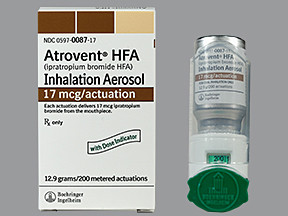IPRATROPIUM HFA INHALER - ORAL
PHONETIC PRONUNCIATION: (IP-ra-TROE-pee-um)
COMMON BRAND NAME(S): Atrovent
GENERIC NAME(S): ipratropium bromide
Uses
USES: Ipratropium is used to control and prevent symptoms (wheezing and shortness of breath) caused by ongoing lung disease (chronic obstructive pulmonary disease-COPD which includes bronchitis and emphysema). It works by relaxing the muscles around the airways so that they open up and you can breathe more easily. Controlling symptoms of breathing problems can decrease time lost from work or school. For preventing symptoms of lung disease, this medication must be used regularly to be effective. Use your quick-relief inhaler (such as albuterol, also called salbutamol in some countries) for wheezing or sudden shortness of breath unless otherwise directed by your doctor. Ipratropium does not work as fast as your quick-relief inhaler, but may sometimes be used to relieve symptoms of wheezing or sudden shortness of breath if so prescribed by your doctor.
How to use IPRATROPIUM HFA INHALER - ORAL
HOW TO USE: Read the Patient Information Leaflet if available from your pharmacist before you start using ipratropium and each time you get a refill. Learn how to use this inhaler properly. If you have any questions, ask your doctor or pharmacist. Follow the instructions for priming the inhaler if you are using it for the first time or if you have not used it for more than 3 days. When priming the inhaler, make sure to spray away from the face so that you do not get the medication into your eyes. Inhale this medication by mouth as directed by your doctor, usually 4 times a day. Avoid getting this medication into your eyes. It may cause eye pain/irritation, temporary blurred vision, and other vision changes. Therefore, when using the inhaler, put your lips tightly around the mouthpiece and keep your eyes closed. If your prescribed dose is 2 puffs, wait at least one minute between them. If you are using other inhalers at the same time, wait at least 1 minute between the use of each medication. Rinse your mouth after using the inhaler to prevent dry mouth and throat irritation. Dosage is based on your medical condition and response to treatment. Clean the mouthpiece of the inhaler once a week with water. Allow to air-dry fully before using again. If you are directed to use this medication regularly, it works best if used at evenly spaced intervals. To help you remember, use it at the same times each day. Do not increase your dose, use this medication more frequently, or stop using it without first consulting your doctor. Keep track of the number of inhalations you use, and throw away the canister after you have used the labeled number of inhalations on the package. Tell your doctor if your symptoms do not improve or if they worsen. Learn which of your inhalers you should use every day (controller drugs) and which you should use if your breathing suddenly worsens (quick-relief drugs). Ask your doctor ahead of time what you should do if you have new or worsening cough or shortness of breath, wheezing, increased sputum, worsening peak flow meter readings, waking up at night with trouble breathing, if you use your quick-relief inhaler more often (more than 2 days a week), or if your quick-relief inhaler does not seem to be working well. Learn when you can treat sudden breathing problems by yourself and when you must get medical help right away.
Side Effects
Precautions
Interactions
Overdose
Images
Reviews
Disclaimer
IMPORTANT: HOW TO USE THIS INFORMATION: This is a summary and does NOT have all possible information about this product. This information does not assure that this product is safe, effective, or appropriate for you. This information is not individual medical advice and does not substitute for the advice of your health care professional. Always ask your health care professional for complete information about this product and your specific health needs.

No Reviews Yet